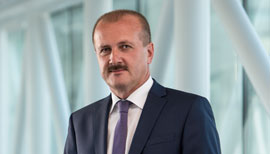
After the painful investment year of 2022, the first half year of 2023 brought some relief. The economy is developing more solidly than expected and there is no deep recession. Corporate earnings have also been better than expected. The peak in interest rates is near and will probably be reached at a key interest rate level of 4.25% to 4.50%. However, the summit will probably be followed by a plateau phase that will clearly extend into 2024. It is definitly too early to discuss rate cuts. Inflation is declining slowly, even if Austria lags behind in fighting inflation and is making home-grown mistakes. Overall, however, demographics are changing the interaction between the economy and the labor market. We see a weakening economy with continued very strong labor markets. Can central banks fight demographics with rate hikes? - Probably not. The danger that the central banks will exaggerate upwards has increased.
The capital market seems to have found its new fair level. Irrespective of the current central bank policy, medium-term corporate bonds have leveled off at yield levels of around 4.4%. "There is no alternative" is therefore history, there are again attractive alternatives to the stock market. From a global perspective, it is remarkable how well the stock markets have performed in the face of the powerful turnaround in interest rates. The so-called equity risk premium in the USA is lower than it has been for a long time and in fact it does not longer exists. In the USA the stock market upswing was supported by a few stocks from the technology sector. The broad market could not keep up with this development, equally weighted indices are well behind the capital-weighted indices. The big companies beat the small companies.
It is not surprising that the Vienna Stock Exchange cannot keep up with global developments in this environment. It is not "growth" that characterizes the index in Vienna, but rather "value" in the sense of the financial, energy and industrial sectors. Especially when the global view is not focused on smaller markets and smaller companies, the strategist can build up long-term positions. The valuation ratios are convincing, the price-earnings ratio based on earnings expectations for the next 12 months is only around 8, the dividend yield is around 5% on average. Many companies convince with long-term strategy and management quality. ERSTE, Andritz and Wienerberger are just a few examples. Vienna is therefore increasingly becoming a dividend market. What is still missing is the comeback of foreign investors, without these buyers a sustainable stock exchange boom in Vienna is not possible.
The tactician knows that the prices of today and tomorrow are written purely by the global news. However, the strategist knows that prices will be driven by business models in the coming quarters and years. The strategist is therefore currently finding many attractive entry-level prices and is not succumbing to the illusion of perfect timing anyway.
Author:
Alois Wögerbauer, CIIA
Executive of 3 Banken-Generali Investment-Gesellschaft m.b.H.
4 July 2023
 |
Note
Wiener Börse AG would explicitly like to point out that the data and calculations given in this report are historic values, which do not permit any conclusions as regards future developments or value stability. Price fluctuations and loss of capital are possible in securities trading. The contribution is the personal opinion of the analyst and does not constitute a financial analysis or a recommendation for investment by the exchange operating company, Wiener Börse AG.
